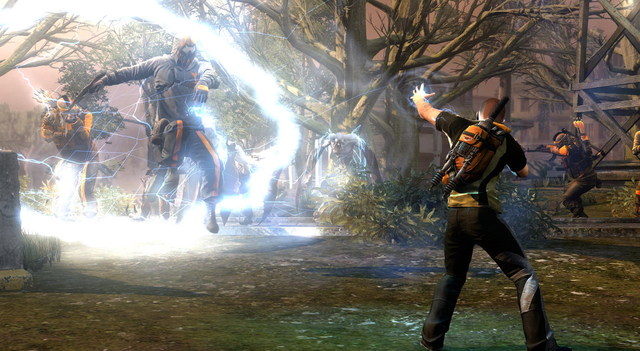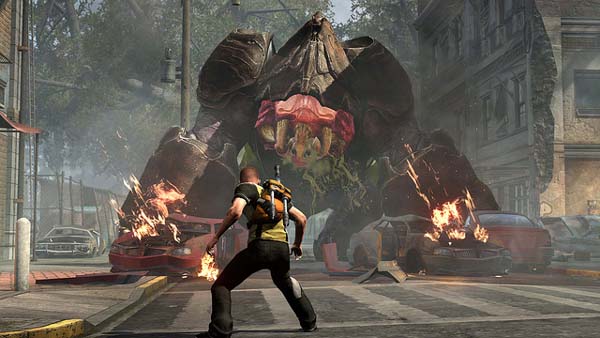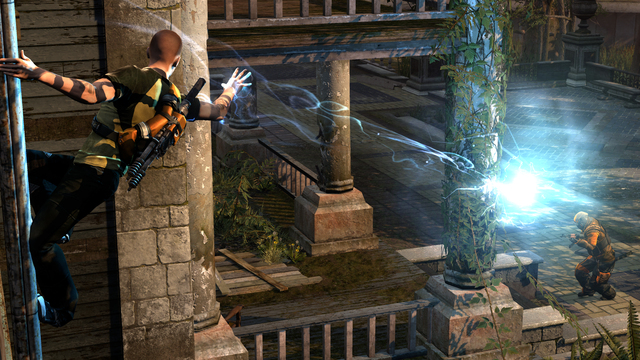This post has not been edited by the GamesBeat staff. Opinions by GamesBeat community writers do not necessarily reflect those of the staff.
A couple weeks ago I had the chance to interview Joe Ishikura, a game designer at Sucker Punch Productions, developer of the recently released PS3 exclusive Infamous 2. He talks about some of the improvements the studio made this time around. He also goes in-depth as to why main character Cole looks so different in the sequel. Below is a full transcript of our chat. Enjoy!
What are you most proud of in Infamous 2?
Joe Ishikura: It’s tough for that one. It’s like picking your favorite child. Every single part of this game was created through blood, sweat, and tears, and iterations of finding out that “You’re so stupid, you shouldn’t have done it that way” — finally you’ve got something that you’re really proud of.

I think overall, presentation is one of my favorite ones, because to me it was unexpected that I would care about it so much. For instance, we have brand-new cut-scenes, we changed the hand that Cole shoots with — we made those kinds of little tweaks across the board, and I think all of those things made the gameplay so much more satisfying.
What’s been improved from the first game?
JI: You know, it’s funny, because we tried to improve everything possible. We have an internal mantra that we repeat to ourselves: “Leave no stone unturned.” And that really means leave nothing holy; everything is on the table to be improved. We obviously improved the most important aspects: the karma, the combat, the powers, and the parkour. Of course, the brand-new thing that we have is UGC [user-generated content]; it’s a brand-new feature.
You worked on the first Infamous as well, so how has your role changed between games?
JI: Well, my role actually changed pretty drastically because I was actually a programmer on Infamous 1 — I worked on side missions a lot. I would work with designers really carefully and implement their ideas.
This time around, I almost feel neutered because I don’t get to do anything by myself any more — like a prototype by myself. As far as what goes into the game, there’s a lot more communication, a lot more talking to people — it’s really cool! This is kind of a jump that I’ve always wanted to make, so I’m really happy Sucker Punch gave me an opportunity to do it.

What was the toughest thing you experienced during the whole development cycle?
JI: You know, they always say that the last 20% of a game is 80% of the work. That was absolutely true with Infamous 2. I was actually just talking to somebody who looked at a build back in November, and he said, “You could see the promise of it, but it was kind of choppy; things didn’t quite work together.” So for us, it’s about looking at that and saying, “What are the absolutely important things that we should change?” and then making improvements on those.
Realistically, we don’t have unlimited time, we don’t have unlimited resources, so we have to pick our spots. For me, the hard part was figuring out how to pick those spots — which ones are the most important things to improve — and then just going from there.
What have you learned from past experiences that helped you out this time, whether that’s from Infamous or just your career in general?
JI: For my career in general, people ask me a lot, “Hey, how do I get into the game industry?” And for me, the big thing that I think helped me the most was that I had a portfolio. I didn’t work at a professional company, but when I was in college, I would actually go out and say, “Hey guys, let’s make a game!” and try to put a team together.
Learning from that process and from working with other people and finishing a game was something that I really had to pull from and say, “OK — I really have to prioritize.” It was about learning the importance of prioritizing, the importance of communication, and of working with everybody. So for me, it was about actual things that I learned in the past, and all of that fed into the game.

How has Cole changed between the first game and Infamous 2?
JI: We actually made a pretty drastic revamp of Cole; it was mostly driven by external factors. We didn’t say, “Hey, let’s change the character design just to change the character design.” We actually had specific things that made us change it. Some of the things we’re talking about are, of course, the Amp [a tuning-fork-like weapon] on his back — things like that change his silhouette. You’re staring at his back of most the time, so it’s a big change. He lost his semi-iconic motorcycle jacket because he’s in New Marais [a fictional version of New Orleans] — goodness, it’s humid and hot there! It does not make any sense for him to wear it there.
Of course, there’s also the facial structure. We had to change that because we wanted to do motion capture. We wanted a mo-cap actor and decided that Eric Laydon was a great choice, but if we had kept the same Infamous 1 face on Cole, it just would not have matched the facial structure, and we would have lost a lot of the nuance.
Yeah, I definitely noticed that. I was kind of curious as to how or why he changed.
JI: Yeah, when you look at it side-by-side you think, we had Cole with hair, and then we took it off; people naturally thought that we went back to the old Infamous 1 Cole. We then have to say, “No, we took off his hair, but his features are still very different, because we had to make it different.”
Based off of what you’ve played in the game, what would you say is the toughest part of Infamous 2?
JI: Gosh, I think for me it’s picking your play style. We tried to do as much as possible to have as much variety in the way you can approach an encounter. So I think that just picking, “How do you want to approach this? How do you humiliate the enemy as best as possible?” is something that people struggle with, because we wanted to give people as many options as we possibly could.

Why did Sucker Punch decide to allow players to import trophies from the first game? What do you do if someone has played through and gotten the platinum trophy and both sides of the story?
JI: Well, right from the get-go, we notice that you have both and then allow you to pick which option you’d like. This is supposed to be a benefit, so we don’t want to lock players down if they don’t want to.
If there were one thing that you could tell people about Infamous 2, what would it be?
JI: I think for me it’s all about the freedom. With Infamous 2 versus the original, I think that we more fully embraced this open-world feel — doing things the way you want to do them. As a player, you have a lot of options. Of course, we have linear content — single-player content that we know how you’re going to approach. But in the open world you can really encounter anything any way that you want. I hope that people really embrace that and say, “I want to figure out the way I want to play the game,” and then play it that way.
Michael Brown has worked as a freelance writer for the past two years doing work for 1UP.com, Lv42.com and more. Recently, he wrote and published his own magazine, Cultured. It features profiles on Capybara Games, Double Fine Productions, and Telltale Games. The magazine also has interviews with some of the creative minds in the industry (such as Nathan Vella, Zack Karlsson, Dave Grossman, and David Cage). If you're interested in reading the magazine, the digital version is available to download for free here.
You can read more of Michael's work at www.michaelrbrown.com.
